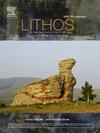Petrogenesis of the Early Cretaceous volcanic-intrusive complex in northern North China Craton: Implications for crustal magma system evolution
IF 2.9
2区 地球科学
Q2 GEOCHEMISTRY & GEOPHYSICS
引用次数: 0
Abstract
Identifying the origin and evolution of silicic magma is crucial for elucidating the transcrustal magmatic system and the evolution of continental crust. The Early Cretaceous volcanic-intrusive complex in the Kulongshan area provides an important insight into the evolution of silicic magma. Zircon U![]() Pb dating indicates that these spatially associated rocks formed between 140 and 131 Ma. The volcanic and subvolcanic rocks and alkali feldspar–alkaline granites are high silica (SiO2 = 75.79–77.89 wt%) and alkali-rich and demonstrate strong negative Eu anomalies (Eu/Eu* = 0.02–0.06), as is typical of A-type rocks. Significant geochemical discontinuities were found between the potassium (K)-feldspar granite porphyry (SiO2 = 67.86–70.80 wt%, Eu/Eu* = 0.20–0.44) and the high-silica rocks. These rocks exhibit εHf(t) and TDM2 values ranging from −18.1 to −9.2 and 2.34 to 1.84 Ga, respectively, indicating that the magmas originated from partial melting of the Paleoproterozoic continental crust. The geochemical characteristics show that the high-silica volcanic and subvolcanic rocks, along with the alkali-feldspar–alkaline granites, display a distinct trend of fractional crystallization. The K-feldspar granite porphyry exhibits distinct characteristics of feldspar accumulation. The consistent material source of the Kulongshan volcanic-intrusive complex suggests that the magma may have ascended from the source area, leading to magma interaction in the deep magma reservoir, followed by fractional crystallization in the shallow magma reservoir. The results indicate that Early Cretaceous high-silica rocks were formed via the extraction and coalescence of interstitial melts within the magma reservoir, with the K-feldspar granite porphyry representing residual crystal accumulation.
Pb dating indicates that these spatially associated rocks formed between 140 and 131 Ma. The volcanic and subvolcanic rocks and alkali feldspar–alkaline granites are high silica (SiO2 = 75.79–77.89 wt%) and alkali-rich and demonstrate strong negative Eu anomalies (Eu/Eu* = 0.02–0.06), as is typical of A-type rocks. Significant geochemical discontinuities were found between the potassium (K)-feldspar granite porphyry (SiO2 = 67.86–70.80 wt%, Eu/Eu* = 0.20–0.44) and the high-silica rocks. These rocks exhibit εHf(t) and TDM2 values ranging from −18.1 to −9.2 and 2.34 to 1.84 Ga, respectively, indicating that the magmas originated from partial melting of the Paleoproterozoic continental crust. The geochemical characteristics show that the high-silica volcanic and subvolcanic rocks, along with the alkali-feldspar–alkaline granites, display a distinct trend of fractional crystallization. The K-feldspar granite porphyry exhibits distinct characteristics of feldspar accumulation. The consistent material source of the Kulongshan volcanic-intrusive complex suggests that the magma may have ascended from the source area, leading to magma interaction in the deep magma reservoir, followed by fractional crystallization in the shallow magma reservoir. The results indicate that Early Cretaceous high-silica rocks were formed via the extraction and coalescence of interstitial melts within the magma reservoir, with the K-feldspar granite porphyry representing residual crystal accumulation.

求助全文
约1分钟内获得全文
求助全文
来源期刊

Lithos
地学-地球化学与地球物理
CiteScore
6.80
自引率
11.40%
发文量
286
审稿时长
3.5 months
期刊介绍:
Lithos publishes original research papers on the petrology, geochemistry and petrogenesis of igneous and metamorphic rocks. Papers on mineralogy/mineral physics related to petrology and petrogenetic problems are also welcomed.
 求助内容:
求助内容: 应助结果提醒方式:
应助结果提醒方式:


